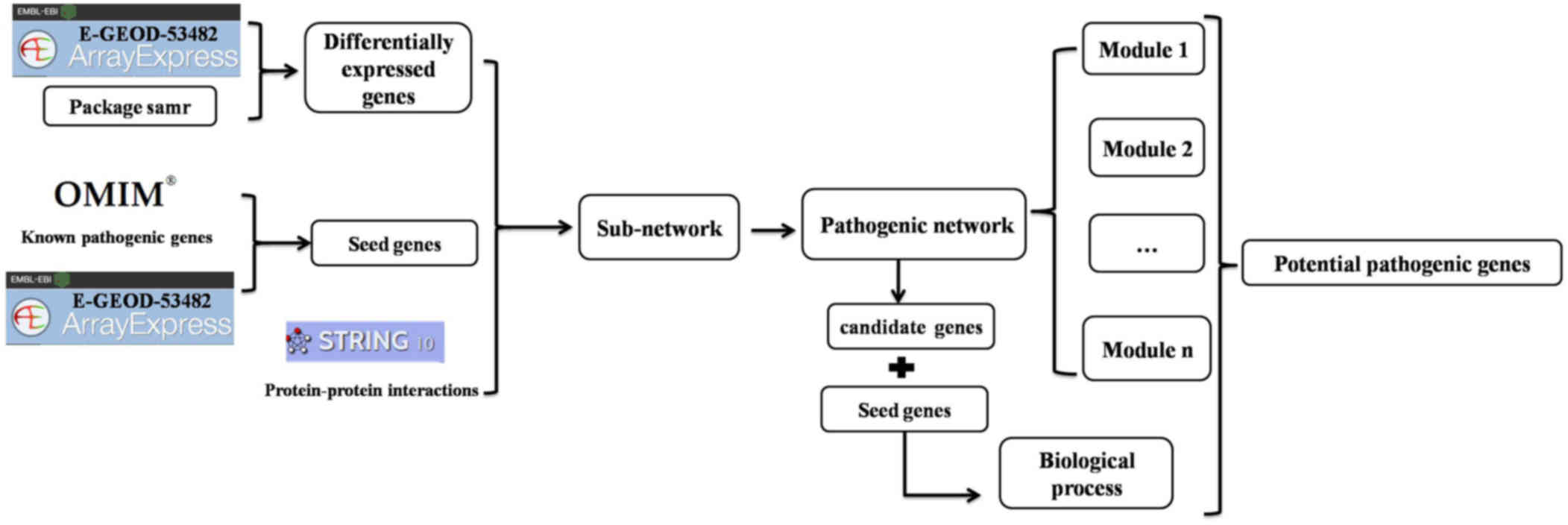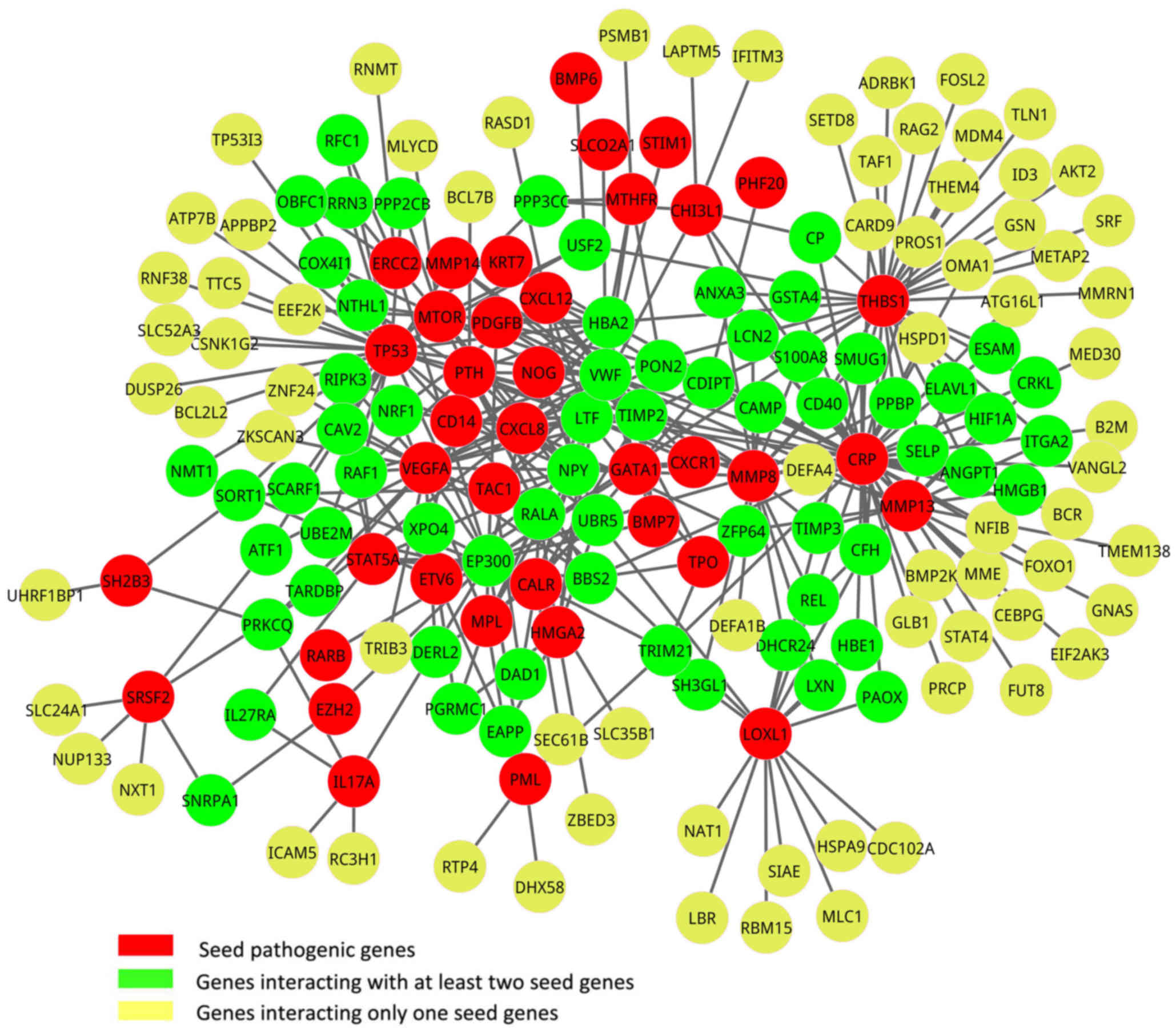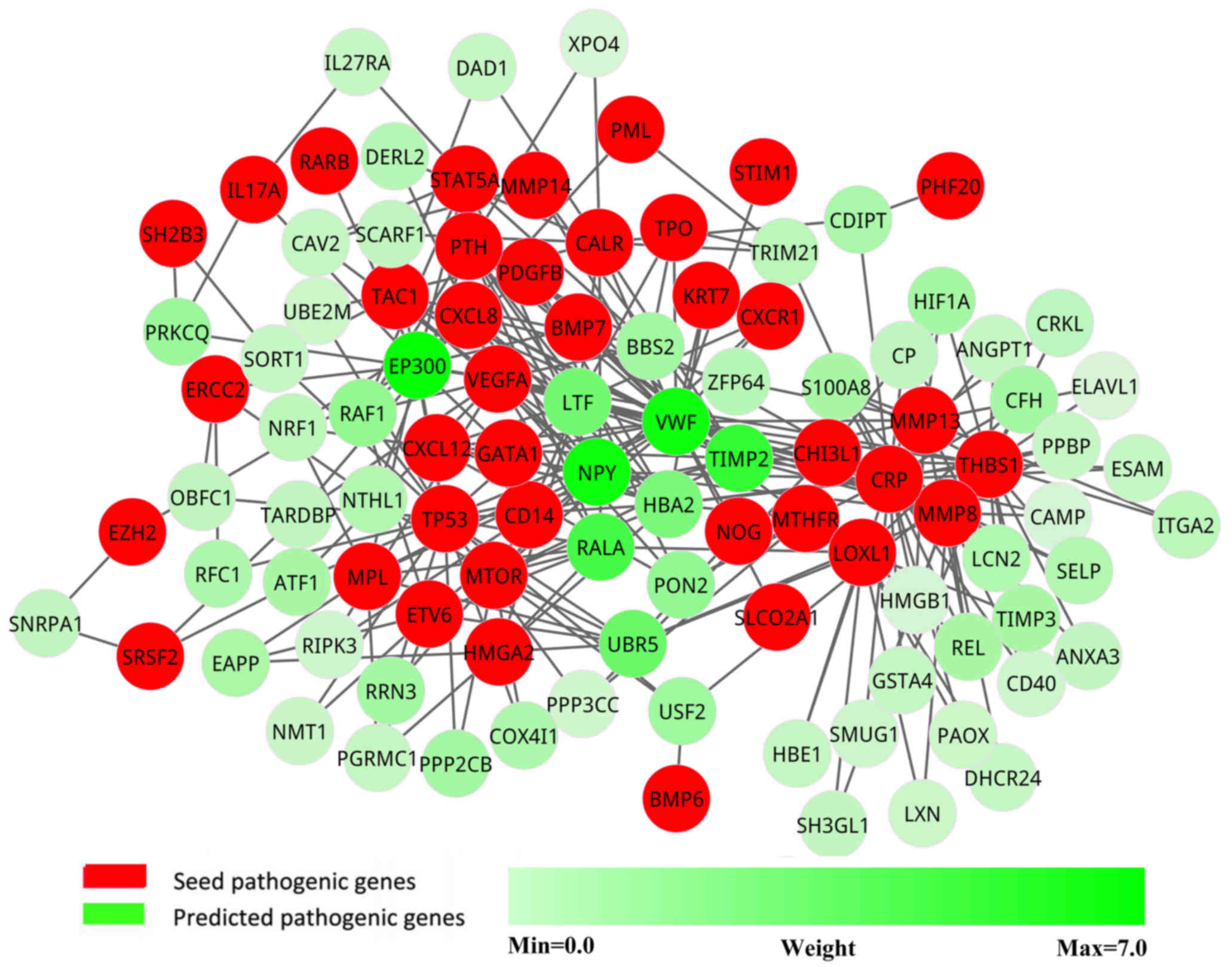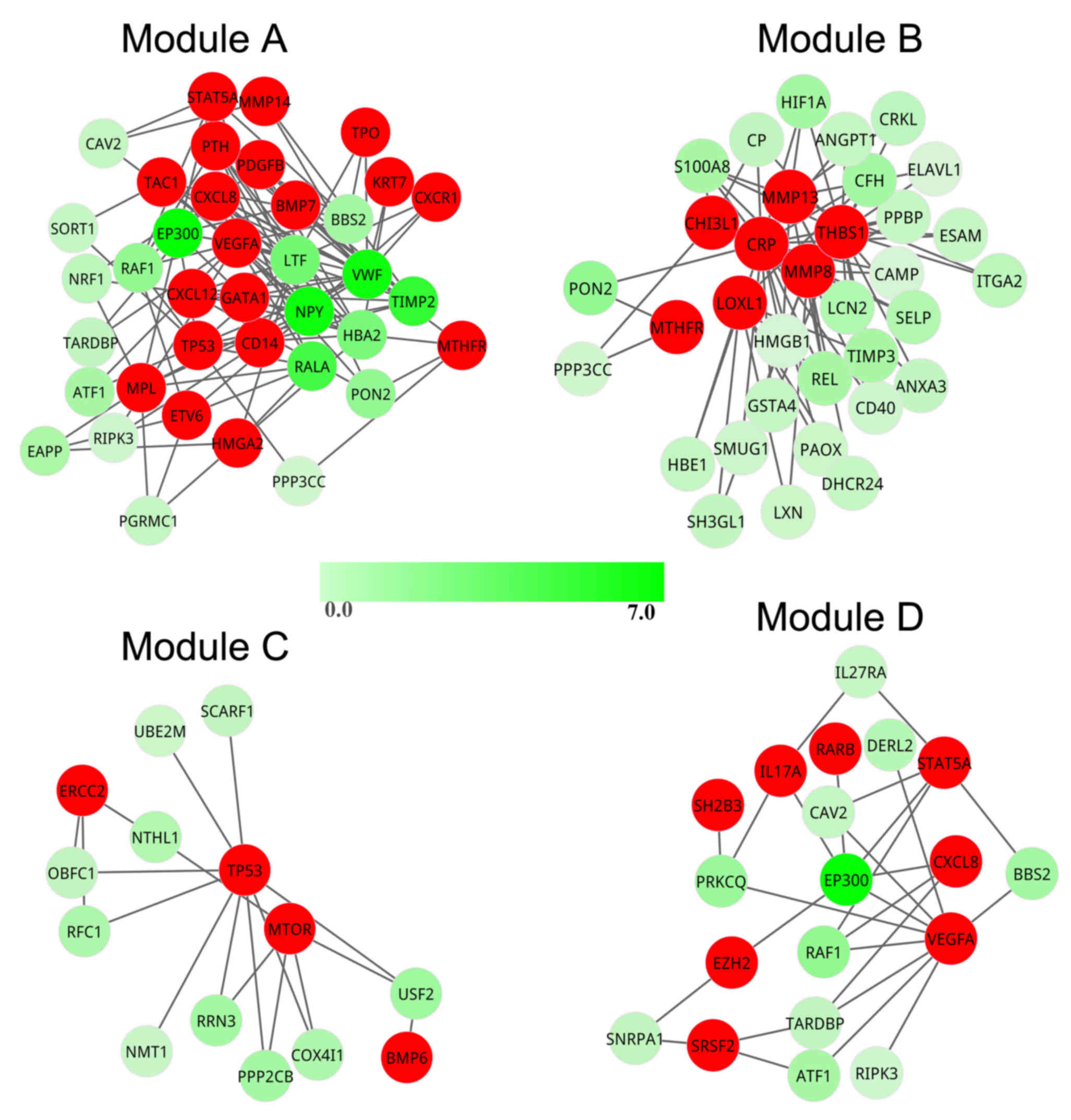|
1
|
Jamieson CH, Barroga CF and Vainchenker
WP: Miscreant myeloproliferative disorder stem cells. Leukemia.
22:2011–2019. 2008. View Article : Google Scholar : PubMed/NCBI
|
|
2
|
Tefferi A and Vardiman JW: Classification
and diagnosis of myeloproliferative neoplasms: The 2008 World
Health Organization criteria and point-of-care diagnostic
algorithms. Leukemia. 22:14–22. 2008. View Article : Google Scholar : PubMed/NCBI
|
|
3
|
Vannucchi AM, Guglielmelli P and Tefferi
A: Advances in understanding and management of myeloproliferative
neoplasms. CA Cancer J Clin. 59:171–191. 2009. View Article : Google Scholar : PubMed/NCBI
|
|
4
|
Triviai I, Ziegler M, Bergholz U, Oler AJ,
Stübig T, Prassolov V, Fehse B, Kozak CA, Kröger N and Stocking C:
Endogenous retrovirus induces leukemia in a xenograft mouse model
for primary myelofibrosis. Proc Natl Acad Sci USA. 111:8595–8600.
2014. View Article : Google Scholar : PubMed/NCBI
|
|
5
|
Levine RL, Wadleigh M, Cools J, Ebert BL,
Wernig G, Huntly BJ, Boggon TJ, Wlodarska I, Clark JJ, Moore S, et
al: Activating mutation in the tyrosine kinase JAK2 in polycythemia
vera, essential thrombocythemia, and myeloid metaplasia with
myelofibrosis. Cancer Cell. 7:387–397. 2005. View Article : Google Scholar : PubMed/NCBI
|
|
6
|
Pardanani AD, Levine RL, Lasho T, Pikman
Y, Mesa RA, Wadleigh M, Steensma DP, Elliott MA, Wolanskyj AP,
Hogan WJ, et al: MPL515 mutations in myeloproliferative and other
myeloid disorders: A study of 1182 patients. Blood. 108:3472–3476.
2006. View Article : Google Scholar : PubMed/NCBI
|
|
7
|
Vannucchi AM, Lasho TL, Guglielmelli P,
Biamonte F, Pardanani A, Pereira A, Finke C, Score J, Gangat N,
Mannarelli C, et al: Mutations and prognosis in primary
myelofibrosis. Leukemia. 27:1861–1869. 2013. View Article : Google Scholar : PubMed/NCBI
|
|
8
|
Tefferi A, Lasho TL, Finke CM, Knudson RA,
Ketterling R, Hanson CH, Maffioli M, Caramazza D, Passamonti F and
Pardanani A: CALR vs JAK2 vs MPL-mutated or triple-negative
myelofibrosis: Clinical, cytogenetic and molecular comparisons.
Leukemia. 28:1472–1477. 2014. View Article : Google Scholar : PubMed/NCBI
|
|
9
|
Kostka D and Spang R: Finding disease
specific alterations in the co-expression of genes. Bioinformatics.
20 Suppl 1:i194–i199. 2004. View Article : Google Scholar : PubMed/NCBI
|
|
10
|
Liu Y, Chen SH, Jin X and Li YM: Analysis
of differentially expressed genes and microRNAs in alcoholic liver
disease. Int J Mol Med. 31:547–554. 2013. View Article : Google Scholar : PubMed/NCBI
|
|
11
|
MacFarlane RC and Singh U: Identification
of differentially expressed genes in virulent and nonvirulent
Entamoeba species: Potential implications for amebic
pathogenesis. Infect Immun. 74:340–351. 2006. View Article : Google Scholar : PubMed/NCBI
|
|
12
|
Lim J, Hao T, Shaw C, Patel AJ, Szabó G,
Rual JF, Fisk CJ, Li N, Smolyar A, Hill DE, et al: A
protein-protein interaction network for human inherited ataxias and
disorders of Purkinje cell degeneration. Cell. 125:801–814. 2006.
View Article : Google Scholar : PubMed/NCBI
|
|
13
|
Liu ZP, Wang Y, Zhang XS and Chen L:
Network-based analysis of complex diseases. IET Syst Biol. 6:22–33.
2012. View Article : Google Scholar : PubMed/NCBI
|
|
14
|
Jia Y, Nie K, Li J, Liang X and Zhang X:
Identification of therapeutic targets for Alzheimer's disease via
differentially expressed gene and weighted gene co-expression
network analyses. Mol Med Rep. 14:4844–4848. 2016. View Article : Google Scholar : PubMed/NCBI
|
|
15
|
Horvath S, Zhang B, Carlson M, Lu KV, Zhu
S, Felciano RM, Laurance MF, Zhao W, Qi S, Chen Z, et al: Analysis
of oncogenic signaling networks in glioblastoma identifies ASPM as
a molecular target. Proc Natl Acad Sci USA. 103:17402–17407. 2006.
View Article : Google Scholar : PubMed/NCBI
|
|
16
|
Jiang W, Li X, Rao S, Wang L, Du L, Li C,
Wu C, Wang H, Wang Y and Yang B: Constructing disease-specific gene
networks using pair-wise relevance metric: Application to colon
cancer identifies interleukin 8, desmin and enolase 1 as the
central elements. BMC Syst Biol. 2:722008. View Article : Google Scholar : PubMed/NCBI
|
|
17
|
Pe'er D and Hacohen N: Principles and
strategies for developing network models in cancer. Cell.
144:864–873. 2011. View Article : Google Scholar : PubMed/NCBI
|
|
18
|
Liu X, Tang WH, Zhao XM and Chen L: A
network approach to predict pathogenic genes for Fusarium
graminearum. PLoS One. 5:e130212010. View Article : Google Scholar : PubMed/NCBI
|
|
19
|
Norfo R, Zini R, Pennucci V, Bianchi E,
Salati S, Guglielmelli P, Bogani C, Fanelli T, Mannarelli C, Rosti
V, et al: miRNA-mRNA integrative analysis in primary myelofibrosis
CD34+ cells: Role of miR-155/JARID2 axis in abnormal
megakaryopoiesis. Blood. 124:e21–e32. 2014. View Article : Google Scholar : PubMed/NCBI
|
|
20
|
Zhao J, Yang TH, Huang Y and Holme P:
Ranking candidate disease genes from gene expression and protein
interaction: A Katz-centrality based approach. PLoS One.
6:e243062011. View Article : Google Scholar : PubMed/NCBI
|
|
21
|
Tusher VG, Tibshirani R and Chu G:
Significance analysis of microarrays applied to the ionizing
radiation response. Proc Natl Acad Sci USA. 98:5116–5121. 2001.
View Article : Google Scholar : PubMed/NCBI
|
|
22
|
Reiner A, Yekutieli D and Benjamini Y:
Identifying differentially expressed genes using false discovery
rate controlling procedures. Bioinformatics. 19:368–375. 2003.
View Article : Google Scholar : PubMed/NCBI
|
|
23
|
Choi JK, Yu U, Yoo OJ and Kim S:
Differential coexpression analysis using microarray data and its
application to human cancer. Bioinformatics. 21:4348–4355. 2005.
View Article : Google Scholar : PubMed/NCBI
|
|
24
|
Ravasz E, Somera AL, Mongru DA, Oltvai ZN
and Barabási AL: Hierarchical organization of modularity in
metabolic networks. Science. 297:1551–1555. 2002. View Article : Google Scholar : PubMed/NCBI
|
|
25
|
Kanehisa M and Goto S: KEGG: Kyoto
Encyclopedia of Genes and Genomes. Nucleic Acids Res. 28:27–30.
2000. View Article : Google Scholar : PubMed/NCBI
|
|
26
|
Huang DW, Sherman BT, Tan Q, Collins JR,
Alvord WG, Roayaei J, Stephens R, Baseler MW, Lane HC and Lempicki
RA: The DAVID gene functional classification tool: A novel
biological module-centric algorithm to functionally analyze large
gene lists. Genome Biol. 8:R1832007. View Article : Google Scholar : PubMed/NCBI
|
|
27
|
Gayther SA, Batley SJ, Linger L, Bannister
A, Thorpe K, Chin SF, Daigo Y, Russell P, Wilson A, Sowter HM, et
al: Mutations truncating the EP300 acetylase in human cancers. Nat
Genet. 24:300–303. 2000. View
Article : Google Scholar : PubMed/NCBI
|
|
28
|
Bryan EJ, Jokubaitis VJ, Chamberlain NL,
Baxter SW, Dawson E, Choong DY and Campbell IG: Mutation analysis
of EP300 in colon, breast and ovarian carcinomas. Int J Cancer.
102:137–141. 2002. View Article : Google Scholar : PubMed/NCBI
|
|
29
|
Ida K, Kitabayashi I, Taki T, Taniwaki M,
Noro K, Yamamoto M, Ohki M and Hayashi Y: Adenoviral E1A-associated
protein p300 is involved in acute myeloid leukemia with
t(11;22)(q23;q13). Blood. 90:4699–4704. 1997.PubMed/NCBI
|
|
30
|
Li B, Gale RP, Xu Z, Qin T, Song Z, Zhang
P, Bai J, Zhang L, Zhang Y, Liu J, et al: Non-driver mutations in
myeloproliferative neoplasm-associated myelofibrosis. J Hematol
Oncol. 10:992017. View Article : Google Scholar : PubMed/NCBI
|
|
31
|
Steensma DP, Pardanani A, Stevenson WS,
Hoyt R, Kiu H, Grigg AP, Szer J, Juneja S, Hilton DJ, Alexander WS
and Roberts AW: More on Myb in myelofibrosis: Molecular analyses of
MYB and EP300 in 55 patients with myeloproliferative disorders.
Blood. 107:1733–1735. 2006. View Article : Google Scholar : PubMed/NCBI
|
|
32
|
Bodemann BO and White MA: Ral GTPases and
cancer: Linchpin support of the tumorigenic platform. Nat Rev
Cancer. 8:133–140. 2008. View Article : Google Scholar : PubMed/NCBI
|
|
33
|
Male H, Patel V, Jacob MA, Borrego-Diaz E,
Wang K, Young DA, Wise AL, Huang C, Van Veldhuizen P,
O'Brien-Ladner A, et al: Inhibition of RalA signaling pathway in
treatment of non-small cell lung cancer. Lung Cancer. 77:252–259.
2012. View Article : Google Scholar : PubMed/NCBI
|
|
34
|
Oxford G and Theodorescu D: The role of
Ras superfamily proteins in bladder cancer progression. J Urol.
170:1987–1993. 2003. View Article : Google Scholar : PubMed/NCBI
|
|
35
|
Neel NF, Stratford JK, Shinde V, Ecsedy
JA, Martin TD, Der CJ and Yeh JJ: Response to MLN8237 in pancreatic
cancer is not dependent on RalA phosphorylation. Mol Cancer Ther.
13:122–133. 2014. View Article : Google Scholar : PubMed/NCBI
|
|
36
|
Győrffy B, Stelniec-Klotz I, Sigler C,
Kasack K, Redmer T, Qian Y and Schäfer R: Effects of RAL signal
transduction in KRAS- and BRAF-mutated cells and prognostic
potential of the RAL signature in colorectal cancer. Oncotarget.
6:13334–13346. 2015. View Article : Google Scholar : PubMed/NCBI
|
|
37
|
Varga A and Baccarini M: RAF-1
(C-RAF)Encyclopedia of Signaling Molecules. Springer; New York: pp.
1562–1570. 2012
|
|
38
|
Leontovich AA, Zhang S, Quatraro C, Iankov
I, Veroux PF, Gambino MW, Degnim A, McCubrey J, Ingle J, Galanis E
and D'Assoro AB: Raf-1 oncogenic signaling is linked to activation
of mesenchymal to epithelial transition pathway in metastatic
breast cancer cells. Int J Oncol. 40:1858–1864. 2012.PubMed/NCBI
|
|
39
|
Maurer G, Tarkowski B and Baccarini M: Raf
kinases in cancer-roles and therapeutic opportunities. Oncogene.
30:3477–3488. 2011. View Article : Google Scholar : PubMed/NCBI
|
|
40
|
Franchini M, Frattini F, Crestani S,
Bonfanti C and Lippi G: von Willebrand factor and cancer: A renewed
interest. Thromb Res. 131:290–292. 2013. View Article : Google Scholar : PubMed/NCBI
|
|
41
|
Morganti M, Carpi A, Amo-Takyi B,
Sagripanti A, Nicolini A, Giardino R and Mittermayer C: Von
Willebrand's factor mediates the adherence of human tumoral cells
to human endothelial cells and ticlopidine interferes with this
effect. Biomed Pharmacother. 54:431–436. 2000. View Article : Google Scholar : PubMed/NCBI
|













